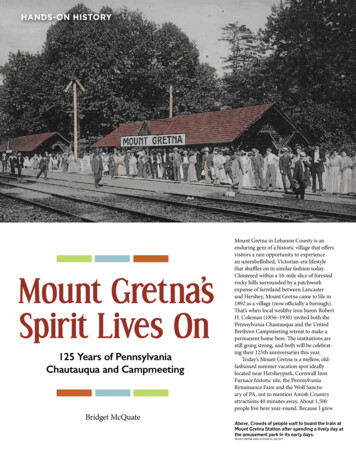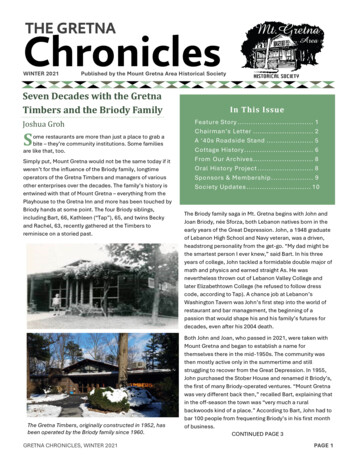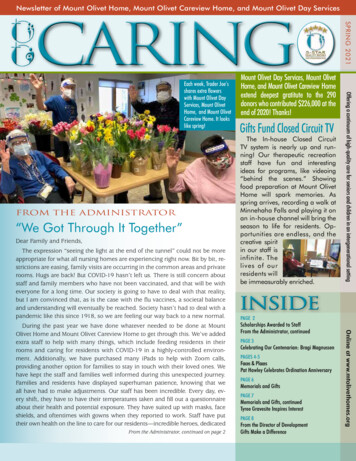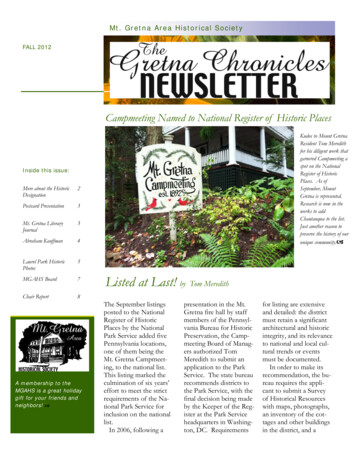
Transcription
HANDS-ON HISTORYMount Gretna’sSpirit Lives On125 Years of PennsylvaniaChautauqua and CampmeetingBridget McQuateMount Gretna in Lebanon County is anenduring gem of a historic village that offersvisitors a rare opportunity to experiencean unembellished, Victorian-era lifestylethat shuffles on in similar fashion today.Cloistered within a 16-mile slice of forestedrocky hills surrounded by a patchworkexpanse of farmland between Lancasterand Hershey, Mount Gretna came to life in1892 as a village (now officially a borough).That’s when local wealthy iron baron RobertH. Coleman (1856–1930) invited both thePennsylvania Chautauqua and the UnitedBrethren Campmeeting retreat to make apermanent home here. The institutions arestill going strong, and both will be celebrating their 125th anniversaries this year.Today’s Mount Gretna is a mellow, oldfashioned summer vacation spot ideallylocated near Hersheypark, Cornwall IronFurnace historic site, the PennsylvaniaRenaissance Faire and the Wolf Sanctuary of PA, not to mention Amish Countryattractions 40 minutes away. About 1,500people live here year-round. Because I grewAbove, Crowds of people wait to board the train atMount Gretna Station after spending a lively day atthe amusement park in its early days.MOUNT GRETNA AREA HISTORICAL SOCIETY
up nearby, I often went to the Victorian-eraMount Gretna Lake & Beach with my teenage friends to goof off on the water trapeze,jump off the high dive, eat hamburgers andfries at the snack shop, and later grab icecream at the Jigger Shop across the road.When I came back with my family 30 yearslater, my original impression remained:Mount Gretna is a unique and timelessplace, if not a bit mysterious. I didn’t fullyunderstand the Chautauqua element andhad even less knowledge of the Campmeeting and Tabernacle ensconced even deeperin the forest, where seemingly mystical,hidden activities take place.To demystify Mount Gretna and understand its historical evolution, I was recentlygiven an insider’s tour with Larry Bowman,a year-round resident and a director onthe Mount Gretna Area Historical Societyboard. The tour started at the cottage thatserves as the historical society’s home, andit continued in a car through the forestedvillage’s steep, serpentine streets lined withcolorful Victorian cottages, complete withobligatory front porches. To unravel theMount Gretna story, let’s start with what’sstill here: Chautauqua and Campmeeting.Pennsylvania ChautauquaMount Gretna was identified as a goodplace to set up a Chautauqua community in1892 when it was already a stop along theCornwall & Lebanon Railroad line, popularfor its lovely picnic grove and playground,amusement park, and swimming lake. ToThe Pennsylvania Chautauqua, founded in Mount Gretna in 1892, offered manyeducational programs in crafts, literature, botany and more.MOUNT GRETNA AREA HISTORICAL SOCIETYunderstand Chautauqua, cast your mindback to 1874, before television, radio, TEDTalks, social media and smart phones. Tofeed people’s appetite for education andenlightenment, a Methodist minister startedthe first Chautauqua Institution on theshores of Chautauqua Lake in New Yorkto deliver lectures on science, philosophy,travel, literature, religion and politics, alongwith art exhibits and performances of comedy, music, dancing and theater. Chautauqua villages sprang up around the country,and a traveling circuit took the movementon the road, setting up inlarge, circuslike tents toentertain and educate themasses. At the peak of themovement in the 1920s, these circuit Chautauquas were attended by 45 million peoplein more than 10,000 communities acrossthe country.Hugely popular on Chautauqua stageswere lectures on topics of reform, morality and inspiration. The politician WilliamJennings Bryan (1860–1925) deliveredfiery speeches on temperance and selfdetermination. Temple University founderRussell Conwell (1843–1925) presented to5,000 Chautauqua audiences the impassioned “Acres of Diamonds” speech, whichAbove, The original Mount Gretna PostOffice, pictured here c. 1910, sat next tothe Chautauqua main entrance gates.MOUNT GRETNA AREA HISTORICAL SOCIETYLeft, Park visitors rent canoes andswim in Lake Conewago as thenarrow-gauge train passes by onits route around the lake.MOUNT GRETNA AREA HISTORICAL SOCIETY
included this famous line: “Get rich youngman, for money is power, and power oughtto be in the hands of good people. I say youhave no right to be poor.” Maud BallingtonBooth (1865-1948) engaged audiences withdramatic storytelling that conveyed mostlymoral messages.Out of more than 200 original Chautauqua communities, Mount Gretna is oneof only 12 that still carries on today, withits steady stream of spring and summerplays, lectures, concerts, art festivals andperformances, which mostly appear on thestage of the open-air Gretna Theater. Othervisible signs of Chautauqua life in MountGretna are centered around the Jigger Shop,Hall of Philosophy, Gretna Emporium,U.S. Post Office and the whimsical cottagesperched on the hill above the village.CampmeetingNow a spiritual center for Methodists,Campmeeting is separated from thePennsylvania Chautauqua by Pinch Road,which climbs steeply up to the peak calledGovernor Dick. In 1892 Coleman invitedThe luxury Conewago Hotel, here ina c. 1910 postcard view, was perchedon a hill overlooking Lake Conewago,which was then part of the largerMount Gretna Amusement Park.MOUNT GRETNA AREA HISTORICAL SOCIETYOriginal cottages in Mount Gretna’s Campmeeting neighborhood look today much like they didin 1892, when most of them were built.MOUNT GRETNA AREA HISTORICAL SOCIETYthe United Brethren Church to make apermanent home for its summer conferences in the same year that the Chautauquawas setting up house. The original Campmeeting included the covered Tabernacleamphitheater surrounded by tents deployedfor 10-day summer conferences. As theretreats came to last for the whole summer,tents were replaced by permanent cottages.As reported in the Lebanon Daily News in1892, “The Chautauqua and Campmeetingare occupied by persons who love to lingeraround the pleasant scenes of this delightfulplace and to drink in all that is to be seenand heard.”The Campmeeting tradition has beengoing strong for 125 years and is complemented by a “newer,” 60-year-old Methodist church built next to the Tabernacle tohost year-round, indoor services. Today’sCampmeeting is an old-timey, fairytale version of a public square with cozy woodencottages and cabins tightly embracing theoval-shaped Tabernacle. The cottages are sodensely packed together that front-porchconversations have been known to spanfour porches across. I asked my tour guideif it would be intrusive for an outsider likeme to walk around among the Chautauquaand Campmeeting cottages. He assured me
In 1889 the narrow-gauge railroad line was created to carry people from the amusement park,around the lake, and up to Governor Dick peak for a spectacular view of the whole region.MOUNT GRETNA AREA HISTORICAL SOCIETYthat residents welcome visitors wholeheartedly and may even try to engage them inconversation from a porch rocking chair.Industrious BeginningsLong before the Pennsylvania Chautauquaand Campmeeting made Mount Gretnatheir home, other forces were at work toshape these wild woodlands into the quaintvillage that you can visit today. Startingin the 1730s, the rocky forests aroundMount Gretna were found to have threekey ingredients to launch a successful ironmanufacturing business: iron ore, limestoneto filter out the ore’s impurities,and hardwood trees to makecharcoal to fuel the smelting fires. Taking advantageof these natural resources in1742, industrialist Peter Grubb(c. 1702–54) established theCornwall Iron Furnace, justdown the road from what isnow Mount Gretna. In 1798 thefirst Robert Coleman (1748–1825) bought the furnace fromGrubb, kicking off a dynasty ofseveral generations of entrepreneurial Colemans who overFor 50 years, starting in 1884,Mount Gretna served as thePennsylvania National Guard’ssummer encampment.MOUNT GRETNA AREA HISTORICAL SOCIETYthe next 100 years transformed this patchof woods into a thriving resort and village.Cornwall Furnace is today preserved as ahistoric site by the Pennsylvania Historical& Museum Commission and is open fortours and events.Rail Stop Evolves into ResortNearly 100 years after iron baron Coleman bought Cornwall Furnace, his greatgrandson Robert H. Coleman became theofficial owner of the family businesses atage nine. In 1884, when he was 26 and awealthy industrialist, his childhood fascina-tion with trains inspiredhim to create the Cornwall& Lebanon (C&L) Railroad.In choosing stops alongthe new C&L line, theColemans selected what isnow Mount Gretna for itspleasant forest with naturalsprings and gorgeouswildflowers to become adestination for picnics andnature gazing.Toward the end of the1880s, the Mount Gretnastop on the C&L evolved from a picnicground into a bustling Gilded Age resort,with an amusement park, a few hotels, astore, a dance hall and the Farm Expo. In1885 Coleman dammed up the ConewagoCreek to create Lake Conewago for swimming and boating (25 cents a ride) next tothe amusement park. People poured offtrains from surrounding towns to ride thecarousel, canoe, swim or wade on the beachin full-body swimsuits, and trip the lightfantastic at the Gretna Gables Dance Hall.More than 5,000 visitors enjoyed the parkduring the first season.In 1884 Coleman lured the PennsylvaniaNational Guard to Mount Gretna for itssummer encampment on several acres of
cleared forest next to the amusement park,where it would return annually for the next50 years. Amusement park visitors wouldsaunter over to watch the marching drillsand cheer on reservists at boxing matches,band concerts and shooting range practice.You can still see the encampment’s paradegrounds that so far have been spared fromdevelopment along Timber Road, betweenthe trail and the village.In 1889 Coleman created a narrowgauge railroad to carry people from thepark, around the lake and up to GovernorDick peak where they could see as far asLancaster and Harrisburg. The luxury Victorian-style Conewago Hotel was built ona hill overlooking the lake in 1909. A competing Kauffman’s Amusement Park laterdeveloped near what is now Campmeeting,offering more modern entertainment like asilent movie theater, a wooden switchbackroller coaster, and a million-gallon swimming pool for a “cooling dip” (as expressedon a postcard from the 1930s). These jauntyresort days kept Mount Gretna hoppinginto the 1940s.Spirit of a Magical PlaceEven before the Great Depression, the StockMarket Panic of 1893 had taken its toll onColeman’s businesses. That same year Cornwall Furnace closed down, the C&L wentbankrupt, and the family moved to NewYork state. In the 1930s the Depression andWorld War II further damaged resort activi-ties. The National Guard was relocatedto Indiantown Gap in 1935. The ConewagoHotel was demolished in 1942, and the lastsurviving amusement park was shuttered inthe 1950s. The emergence of the automobilealso had an impact as people no longer hadto rely on rail destinations.But Mount Gretna survived and continued to maintain its period essence. Inrecent years, the C&L line was reincarnatedas a gravel trail for hiking and biking andis well maintained by the Lebanon ValleyRails to Trails system. The narrow-gaugetracks have been swallowed up by the everhungry forest. On a recent walk on the trail,I envisioned the big steam trains chuggingthrough the forest years ago, unloadingwomen in flouncy, floor-length skirts andmen in bow ties and boater hats who woulddescend the steps to the amusement park, eat lunch on the stonefountain, swim, boat, or ride theopen-sided, narrow-gauge trainaround the lake.The chugging and steaminghave been replaced by the callingof birds, the gravelly crunch ofbicycles and the humming ofcars where the path veers nearthe few roads through town. Thetrain station is gone, but you cansee its foundations covered bytenacious foliage along the trailnear the path to the village. Therusted water tank that servicedthe station is easier to spot acrossfrom the remains of the old stonefountain. Memories of the storiedresort and encampment days canbe relived at the Mount GretnaArea Historical Society throughphotographs, posters, memorabilia and even a carousel horsewith accompanying Wurlitzerpipe organ and self-playingdrum.A popular attraction at the MountGretna Amusement Park was thecarousel, pictured here in thepark’s early days around 1900.MOUNT GRETNA AREA HISTORICAL SOCIETY
The former C&L Railroad line and this surviving railroad bridgeare now part of the Lebanon Valley Rails to Trails system.The Mount Gretna Lake & Beach area looks much the same as it did in 1885 whenRobert H. Coleman had the Conewago Creek dammed up to create the lake.COURTESY BRIDGET McQUATE/PHOTO BY RALPH JOHNSONCOURTESY BRIDGET McQUATE/PHOTO BY RALPH JOHNSONThe fact that two Victorian-era institutions, Chautauqua and Campmeeting, havesurvived into the 21st century is due inpart to their old-fashioned charm and theenduring vision and curiosity of MountGretna’s residents through the years. AsBowman expresses it, “Mount Gretna ismore than just a place to live. This community has attracted a strong mix of artists,educators, businesspeople and others whoappreciate the quality of life and activitiesprovided by the Chautauqua, Campmeetingand other organizations.” Another residentfamously said that Mount Gretna is not aplace, but a spirit. It’s also a window to thepast, where you can play mini-golf on acourse unchanged since the 1920s, rollerThe open-air Gretna Theater still carrieson the Chautauqua tradition of presentingplays, concerts, lectures and other educational programs for residents and visitors.COURTESY BRIDGET McQUATE/PHOTO BY RALPH JOHNSONskate in the original Farm Expo buildingfrom 1890, swim in a lake, bike or hike, allwhile appreciating the natural world thatmakes this place so serene and special.Spend a little time here, and you’ll be transported back to the past to experience theunique tale of a growing country yearningfor education, culture and entertainment.Bridget McQuate is a freelance writer basedin the Philadelphia area who has publishedmore than 30 articles on travel, lifestyle andarchitecture. She was formerly the editorof The Philadelphia Architect and wrotethe Architect’s Brag Book column for ThePhiladelphia Inquirer’s Home & Designmagazine.In 2017 the Pennsylvania Chautauquaand the Campmeeting in Mount Gretna will be celebrating their 125thanniversaries through the assistanceof the Mount Gretna Area HistoricalSociety.For information on activities andevents, visit mtgretnahistory.org.
ary of PA, not to mention Amish Country attractions 40 minutes away. About 1,500 people live here year-round. Because I grew 125 Years of Pennsylvania Chautauqua and Campmeeting Mount Gretna's Spirit Lives On Bridget McQuate HANDS-ON HISTORY Above, Crowds of people wait to board the train at Mount Gretna Station after spending a lively day at










